BSB126 Marketing Plan: Milo Brand Growth and Awareness Strategy
VerifiedAdded on 2023/06/03
|12
|2974
|382
Report
AI Summary
This marketing plan addresses the stagnation in Milo's sales by focusing on increasing brand awareness and capturing new market segments. The plan includes a situation analysis highlighting Milo's strengths as a global brand but also acknowledging challenges such as high sugar content and competition. The core strategy involves diversifying the target market to include older demographics and health-conscious consumers by introducing low-sugar product variations. Tactics include innovative product offerings, strategic pricing, enhanced distribution channels, and promotional activities centered around health and energy. The plan leverages Milo's existing brand equity and aims to reinforce its position as a leading nutritional beverage while addressing consumer concerns about sugar content. Desklib offers a wealth of resources, including past papers and solved assignments, to support students in their academic endeavors.
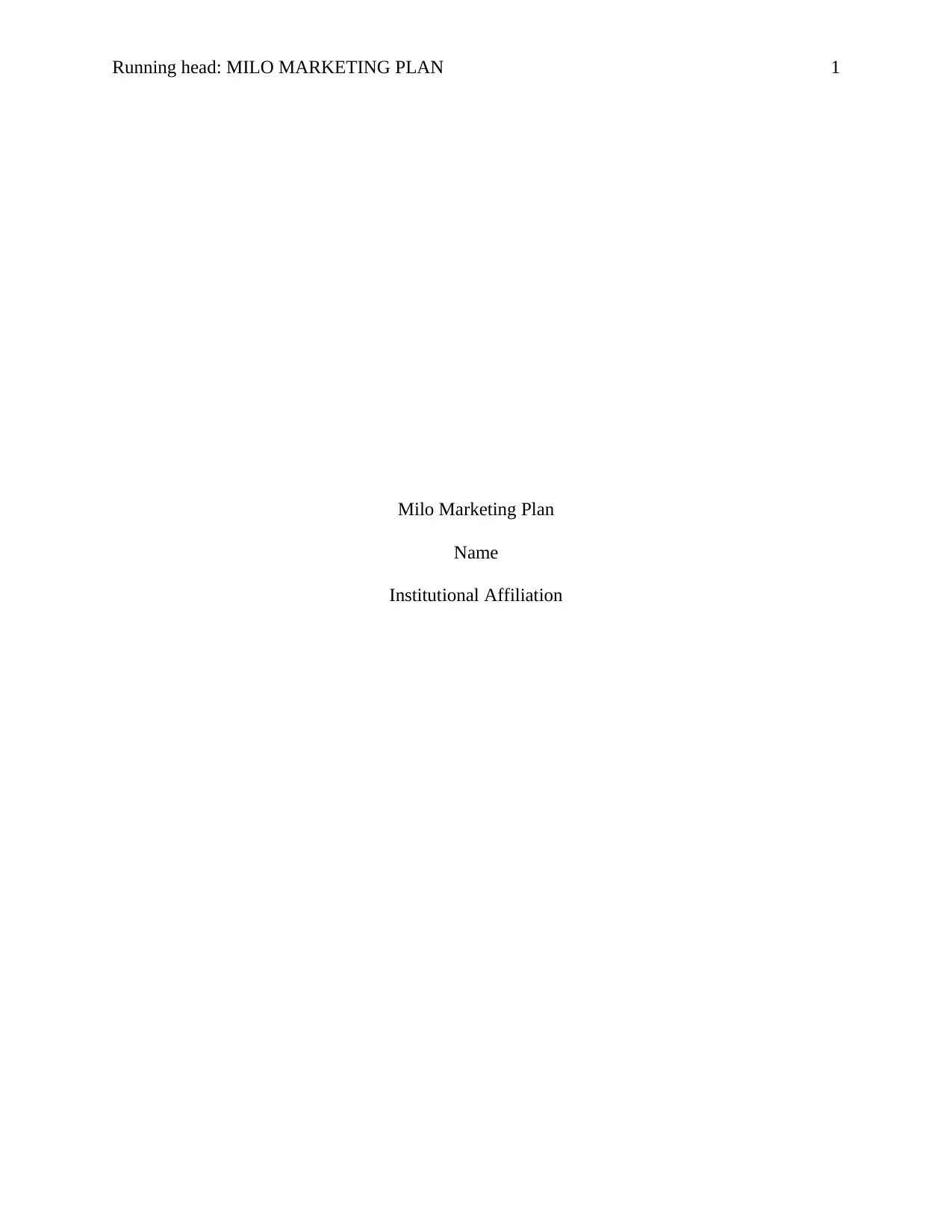
Running head: MILO MARKETING PLAN 1
Milo Marketing Plan
Name
Institutional Affiliation
Milo Marketing Plan
Name
Institutional Affiliation
Paraphrase This Document
Need a fresh take? Get an instant paraphrase of this document with our AI Paraphraser
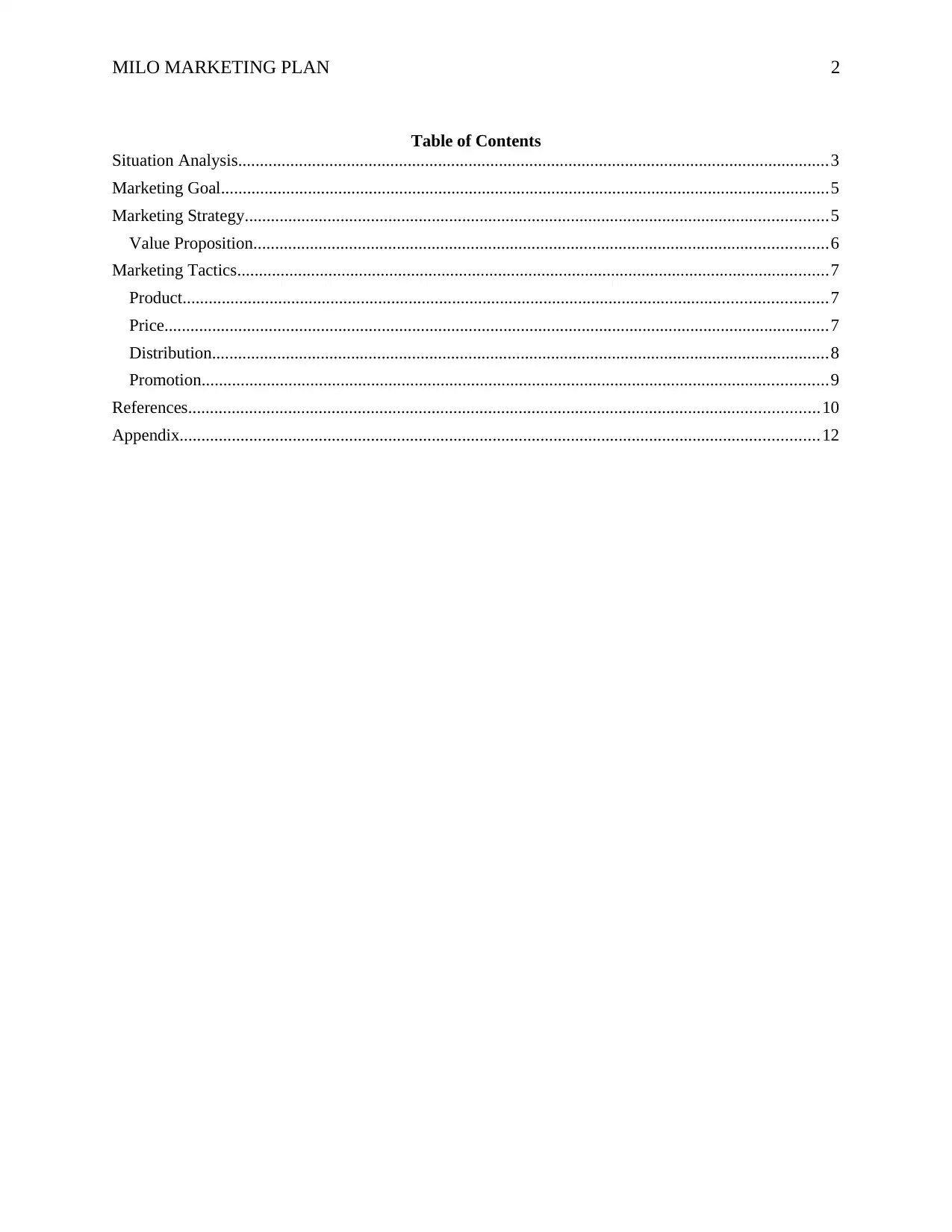
MILO MARKETING PLAN 2
Table of Contents
Situation Analysis........................................................................................................................................3
Marketing Goal............................................................................................................................................5
Marketing Strategy......................................................................................................................................5
Value Proposition....................................................................................................................................6
Marketing Tactics........................................................................................................................................7
Product....................................................................................................................................................7
Price.........................................................................................................................................................7
Distribution..............................................................................................................................................8
Promotion................................................................................................................................................9
References.................................................................................................................................................10
Appendix...................................................................................................................................................12
Table of Contents
Situation Analysis........................................................................................................................................3
Marketing Goal............................................................................................................................................5
Marketing Strategy......................................................................................................................................5
Value Proposition....................................................................................................................................6
Marketing Tactics........................................................................................................................................7
Product....................................................................................................................................................7
Price.........................................................................................................................................................7
Distribution..............................................................................................................................................8
Promotion................................................................................................................................................9
References.................................................................................................................................................10
Appendix...................................................................................................................................................12
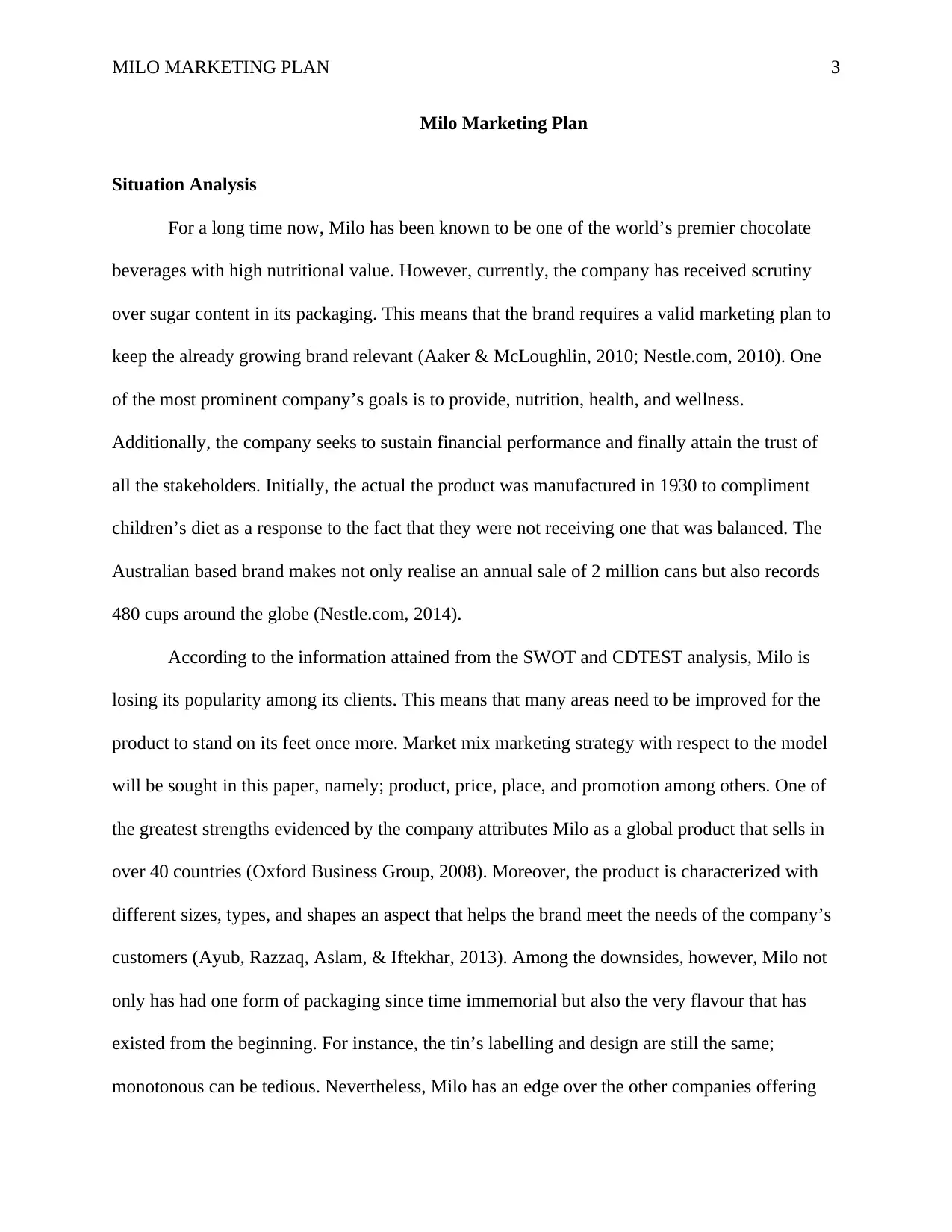
MILO MARKETING PLAN 3
Milo Marketing Plan
Situation Analysis
For a long time now, Milo has been known to be one of the world’s premier chocolate
beverages with high nutritional value. However, currently, the company has received scrutiny
over sugar content in its packaging. This means that the brand requires a valid marketing plan to
keep the already growing brand relevant (Aaker & McLoughlin, 2010; Nestle.com, 2010). One
of the most prominent company’s goals is to provide, nutrition, health, and wellness.
Additionally, the company seeks to sustain financial performance and finally attain the trust of
all the stakeholders. Initially, the actual the product was manufactured in 1930 to compliment
children’s diet as a response to the fact that they were not receiving one that was balanced. The
Australian based brand makes not only realise an annual sale of 2 million cans but also records
480 cups around the globe (Nestle.com, 2014).
According to the information attained from the SWOT and CDTEST analysis, Milo is
losing its popularity among its clients. This means that many areas need to be improved for the
product to stand on its feet once more. Market mix marketing strategy with respect to the model
will be sought in this paper, namely; product, price, place, and promotion among others. One of
the greatest strengths evidenced by the company attributes Milo as a global product that sells in
over 40 countries (Oxford Business Group, 2008). Moreover, the product is characterized with
different sizes, types, and shapes an aspect that helps the brand meet the needs of the company’s
customers (Ayub, Razzaq, Aslam, & Iftekhar, 2013). Among the downsides, however, Milo not
only has had one form of packaging since time immemorial but also the very flavour that has
existed from the beginning. For instance, the tin’s labelling and design are still the same;
monotonous can be tedious. Nevertheless, Milo has an edge over the other companies offering
Milo Marketing Plan
Situation Analysis
For a long time now, Milo has been known to be one of the world’s premier chocolate
beverages with high nutritional value. However, currently, the company has received scrutiny
over sugar content in its packaging. This means that the brand requires a valid marketing plan to
keep the already growing brand relevant (Aaker & McLoughlin, 2010; Nestle.com, 2010). One
of the most prominent company’s goals is to provide, nutrition, health, and wellness.
Additionally, the company seeks to sustain financial performance and finally attain the trust of
all the stakeholders. Initially, the actual the product was manufactured in 1930 to compliment
children’s diet as a response to the fact that they were not receiving one that was balanced. The
Australian based brand makes not only realise an annual sale of 2 million cans but also records
480 cups around the globe (Nestle.com, 2014).
According to the information attained from the SWOT and CDTEST analysis, Milo is
losing its popularity among its clients. This means that many areas need to be improved for the
product to stand on its feet once more. Market mix marketing strategy with respect to the model
will be sought in this paper, namely; product, price, place, and promotion among others. One of
the greatest strengths evidenced by the company attributes Milo as a global product that sells in
over 40 countries (Oxford Business Group, 2008). Moreover, the product is characterized with
different sizes, types, and shapes an aspect that helps the brand meet the needs of the company’s
customers (Ayub, Razzaq, Aslam, & Iftekhar, 2013). Among the downsides, however, Milo not
only has had one form of packaging since time immemorial but also the very flavour that has
existed from the beginning. For instance, the tin’s labelling and design are still the same;
monotonous can be tedious. Nevertheless, Milo has an edge over the other companies offering
⊘ This is a preview!⊘
Do you want full access?
Subscribe today to unlock all pages.

Trusted by 1+ million students worldwide
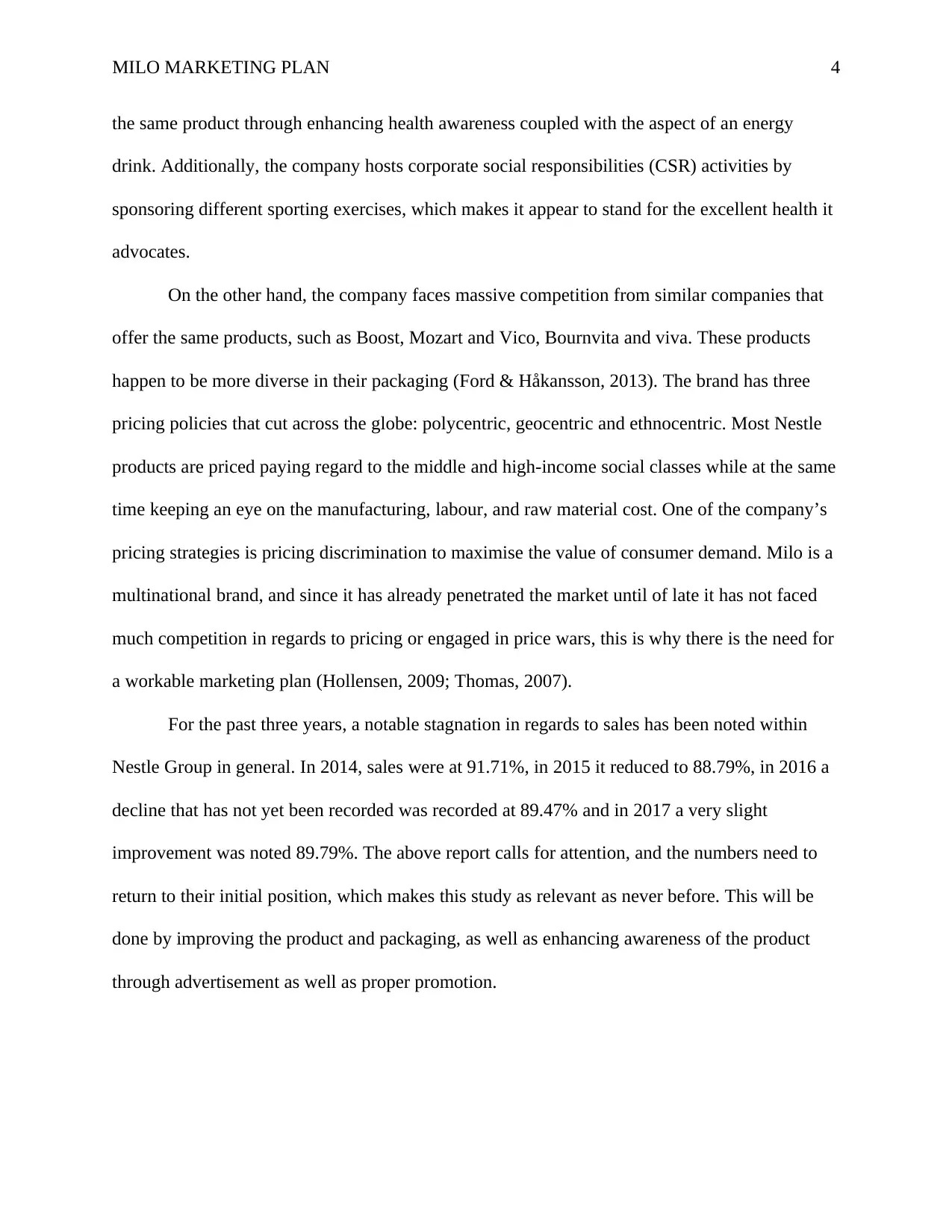
MILO MARKETING PLAN 4
the same product through enhancing health awareness coupled with the aspect of an energy
drink. Additionally, the company hosts corporate social responsibilities (CSR) activities by
sponsoring different sporting exercises, which makes it appear to stand for the excellent health it
advocates.
On the other hand, the company faces massive competition from similar companies that
offer the same products, such as Boost, Mozart and Vico, Bournvita and viva. These products
happen to be more diverse in their packaging (Ford & Håkansson, 2013). The brand has three
pricing policies that cut across the globe: polycentric, geocentric and ethnocentric. Most Nestle
products are priced paying regard to the middle and high-income social classes while at the same
time keeping an eye on the manufacturing, labour, and raw material cost. One of the company’s
pricing strategies is pricing discrimination to maximise the value of consumer demand. Milo is a
multinational brand, and since it has already penetrated the market until of late it has not faced
much competition in regards to pricing or engaged in price wars, this is why there is the need for
a workable marketing plan (Hollensen, 2009; Thomas, 2007).
For the past three years, a notable stagnation in regards to sales has been noted within
Nestle Group in general. In 2014, sales were at 91.71%, in 2015 it reduced to 88.79%, in 2016 a
decline that has not yet been recorded was recorded at 89.47% and in 2017 a very slight
improvement was noted 89.79%. The above report calls for attention, and the numbers need to
return to their initial position, which makes this study as relevant as never before. This will be
done by improving the product and packaging, as well as enhancing awareness of the product
through advertisement as well as proper promotion.
the same product through enhancing health awareness coupled with the aspect of an energy
drink. Additionally, the company hosts corporate social responsibilities (CSR) activities by
sponsoring different sporting exercises, which makes it appear to stand for the excellent health it
advocates.
On the other hand, the company faces massive competition from similar companies that
offer the same products, such as Boost, Mozart and Vico, Bournvita and viva. These products
happen to be more diverse in their packaging (Ford & Håkansson, 2013). The brand has three
pricing policies that cut across the globe: polycentric, geocentric and ethnocentric. Most Nestle
products are priced paying regard to the middle and high-income social classes while at the same
time keeping an eye on the manufacturing, labour, and raw material cost. One of the company’s
pricing strategies is pricing discrimination to maximise the value of consumer demand. Milo is a
multinational brand, and since it has already penetrated the market until of late it has not faced
much competition in regards to pricing or engaged in price wars, this is why there is the need for
a workable marketing plan (Hollensen, 2009; Thomas, 2007).
For the past three years, a notable stagnation in regards to sales has been noted within
Nestle Group in general. In 2014, sales were at 91.71%, in 2015 it reduced to 88.79%, in 2016 a
decline that has not yet been recorded was recorded at 89.47% and in 2017 a very slight
improvement was noted 89.79%. The above report calls for attention, and the numbers need to
return to their initial position, which makes this study as relevant as never before. This will be
done by improving the product and packaging, as well as enhancing awareness of the product
through advertisement as well as proper promotion.
Paraphrase This Document
Need a fresh take? Get an instant paraphrase of this document with our AI Paraphraser
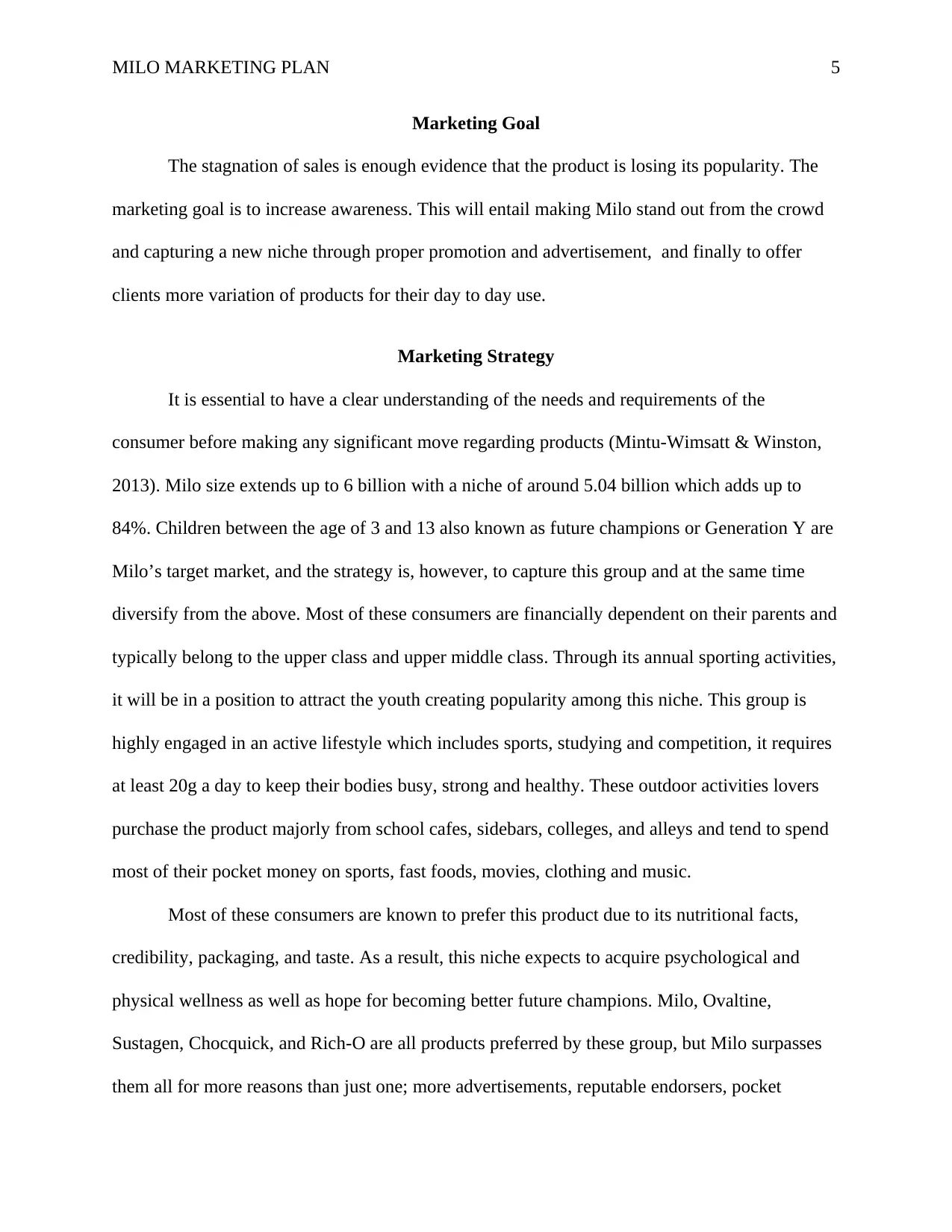
MILO MARKETING PLAN 5
Marketing Goal
The stagnation of sales is enough evidence that the product is losing its popularity. The
marketing goal is to increase awareness. This will entail making Milo stand out from the crowd
and capturing a new niche through proper promotion and advertisement, and finally to offer
clients more variation of products for their day to day use.
Marketing Strategy
It is essential to have a clear understanding of the needs and requirements of the
consumer before making any significant move regarding products (Mintu-Wimsatt & Winston,
2013). Milo size extends up to 6 billion with a niche of around 5.04 billion which adds up to
84%. Children between the age of 3 and 13 also known as future champions or Generation Y are
Milo’s target market, and the strategy is, however, to capture this group and at the same time
diversify from the above. Most of these consumers are financially dependent on their parents and
typically belong to the upper class and upper middle class. Through its annual sporting activities,
it will be in a position to attract the youth creating popularity among this niche. This group is
highly engaged in an active lifestyle which includes sports, studying and competition, it requires
at least 20g a day to keep their bodies busy, strong and healthy. These outdoor activities lovers
purchase the product majorly from school cafes, sidebars, colleges, and alleys and tend to spend
most of their pocket money on sports, fast foods, movies, clothing and music.
Most of these consumers are known to prefer this product due to its nutritional facts,
credibility, packaging, and taste. As a result, this niche expects to acquire psychological and
physical wellness as well as hope for becoming better future champions. Milo, Ovaltine,
Sustagen, Chocquick, and Rich-O are all products preferred by these group, but Milo surpasses
them all for more reasons than just one; more advertisements, reputable endorsers, pocket
Marketing Goal
The stagnation of sales is enough evidence that the product is losing its popularity. The
marketing goal is to increase awareness. This will entail making Milo stand out from the crowd
and capturing a new niche through proper promotion and advertisement, and finally to offer
clients more variation of products for their day to day use.
Marketing Strategy
It is essential to have a clear understanding of the needs and requirements of the
consumer before making any significant move regarding products (Mintu-Wimsatt & Winston,
2013). Milo size extends up to 6 billion with a niche of around 5.04 billion which adds up to
84%. Children between the age of 3 and 13 also known as future champions or Generation Y are
Milo’s target market, and the strategy is, however, to capture this group and at the same time
diversify from the above. Most of these consumers are financially dependent on their parents and
typically belong to the upper class and upper middle class. Through its annual sporting activities,
it will be in a position to attract the youth creating popularity among this niche. This group is
highly engaged in an active lifestyle which includes sports, studying and competition, it requires
at least 20g a day to keep their bodies busy, strong and healthy. These outdoor activities lovers
purchase the product majorly from school cafes, sidebars, colleges, and alleys and tend to spend
most of their pocket money on sports, fast foods, movies, clothing and music.
Most of these consumers are known to prefer this product due to its nutritional facts,
credibility, packaging, and taste. As a result, this niche expects to acquire psychological and
physical wellness as well as hope for becoming better future champions. Milo, Ovaltine,
Sustagen, Chocquick, and Rich-O are all products preferred by these group, but Milo surpasses
them all for more reasons than just one; more advertisements, reputable endorsers, pocket
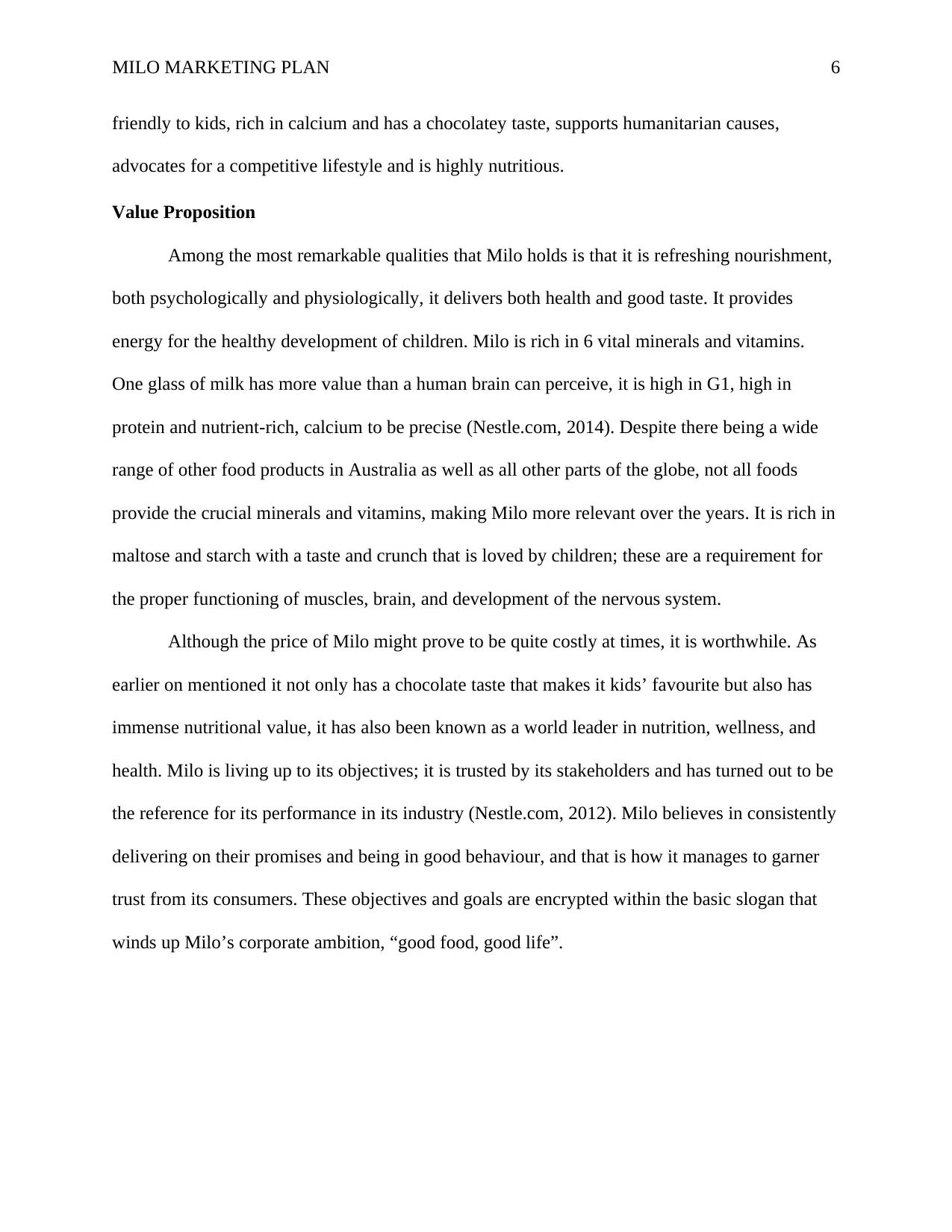
MILO MARKETING PLAN 6
friendly to kids, rich in calcium and has a chocolatey taste, supports humanitarian causes,
advocates for a competitive lifestyle and is highly nutritious.
Value Proposition
Among the most remarkable qualities that Milo holds is that it is refreshing nourishment,
both psychologically and physiologically, it delivers both health and good taste. It provides
energy for the healthy development of children. Milo is rich in 6 vital minerals and vitamins.
One glass of milk has more value than a human brain can perceive, it is high in G1, high in
protein and nutrient-rich, calcium to be precise (Nestle.com, 2014). Despite there being a wide
range of other food products in Australia as well as all other parts of the globe, not all foods
provide the crucial minerals and vitamins, making Milo more relevant over the years. It is rich in
maltose and starch with a taste and crunch that is loved by children; these are a requirement for
the proper functioning of muscles, brain, and development of the nervous system.
Although the price of Milo might prove to be quite costly at times, it is worthwhile. As
earlier on mentioned it not only has a chocolate taste that makes it kids’ favourite but also has
immense nutritional value, it has also been known as a world leader in nutrition, wellness, and
health. Milo is living up to its objectives; it is trusted by its stakeholders and has turned out to be
the reference for its performance in its industry (Nestle.com, 2012). Milo believes in consistently
delivering on their promises and being in good behaviour, and that is how it manages to garner
trust from its consumers. These objectives and goals are encrypted within the basic slogan that
winds up Milo’s corporate ambition, “good food, good life”.
friendly to kids, rich in calcium and has a chocolatey taste, supports humanitarian causes,
advocates for a competitive lifestyle and is highly nutritious.
Value Proposition
Among the most remarkable qualities that Milo holds is that it is refreshing nourishment,
both psychologically and physiologically, it delivers both health and good taste. It provides
energy for the healthy development of children. Milo is rich in 6 vital minerals and vitamins.
One glass of milk has more value than a human brain can perceive, it is high in G1, high in
protein and nutrient-rich, calcium to be precise (Nestle.com, 2014). Despite there being a wide
range of other food products in Australia as well as all other parts of the globe, not all foods
provide the crucial minerals and vitamins, making Milo more relevant over the years. It is rich in
maltose and starch with a taste and crunch that is loved by children; these are a requirement for
the proper functioning of muscles, brain, and development of the nervous system.
Although the price of Milo might prove to be quite costly at times, it is worthwhile. As
earlier on mentioned it not only has a chocolate taste that makes it kids’ favourite but also has
immense nutritional value, it has also been known as a world leader in nutrition, wellness, and
health. Milo is living up to its objectives; it is trusted by its stakeholders and has turned out to be
the reference for its performance in its industry (Nestle.com, 2012). Milo believes in consistently
delivering on their promises and being in good behaviour, and that is how it manages to garner
trust from its consumers. These objectives and goals are encrypted within the basic slogan that
winds up Milo’s corporate ambition, “good food, good life”.
⊘ This is a preview!⊘
Do you want full access?
Subscribe today to unlock all pages.

Trusted by 1+ million students worldwide
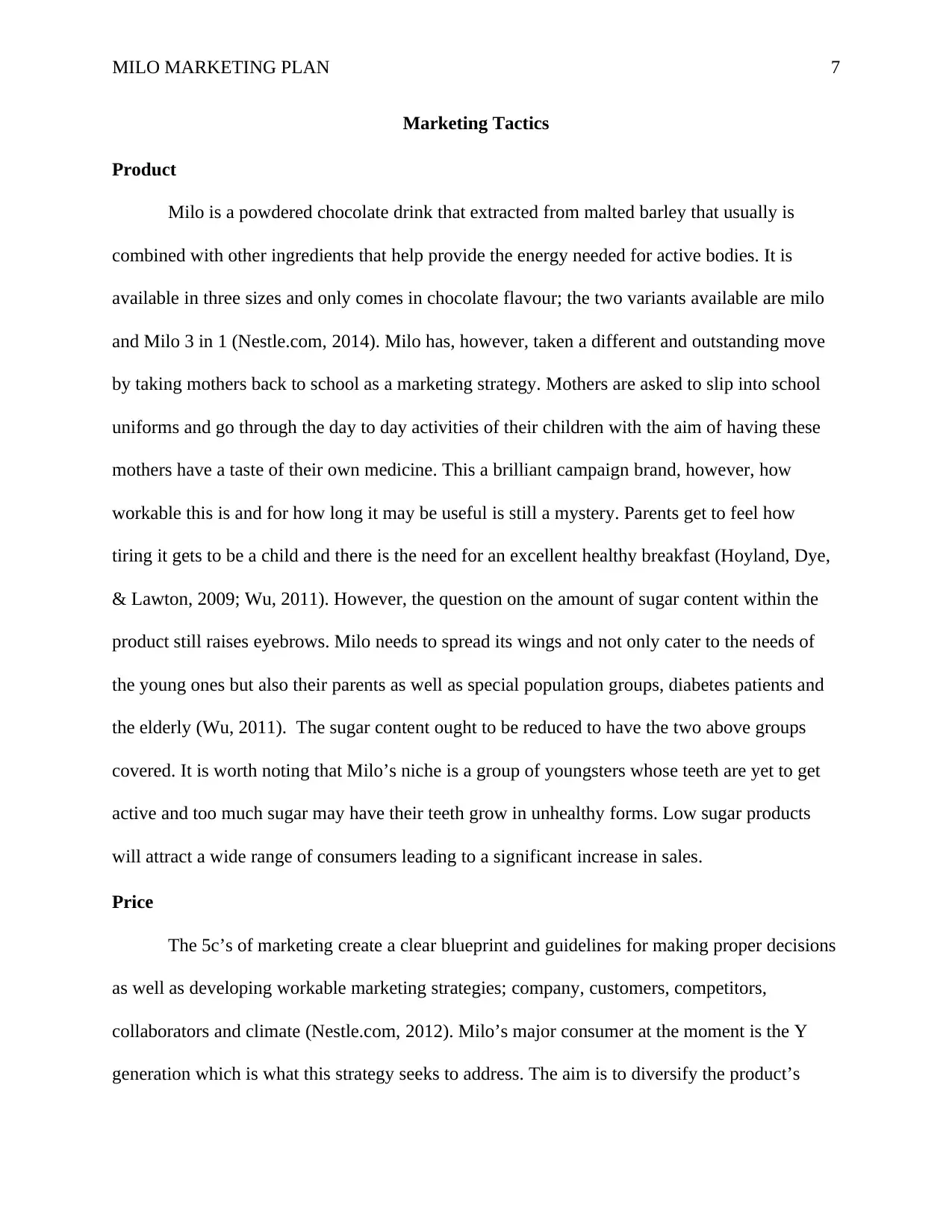
MILO MARKETING PLAN 7
Marketing Tactics
Product
Milo is a powdered chocolate drink that extracted from malted barley that usually is
combined with other ingredients that help provide the energy needed for active bodies. It is
available in three sizes and only comes in chocolate flavour; the two variants available are milo
and Milo 3 in 1 (Nestle.com, 2014). Milo has, however, taken a different and outstanding move
by taking mothers back to school as a marketing strategy. Mothers are asked to slip into school
uniforms and go through the day to day activities of their children with the aim of having these
mothers have a taste of their own medicine. This a brilliant campaign brand, however, how
workable this is and for how long it may be useful is still a mystery. Parents get to feel how
tiring it gets to be a child and there is the need for an excellent healthy breakfast (Hoyland, Dye,
& Lawton, 2009; Wu, 2011). However, the question on the amount of sugar content within the
product still raises eyebrows. Milo needs to spread its wings and not only cater to the needs of
the young ones but also their parents as well as special population groups, diabetes patients and
the elderly (Wu, 2011). The sugar content ought to be reduced to have the two above groups
covered. It is worth noting that Milo’s niche is a group of youngsters whose teeth are yet to get
active and too much sugar may have their teeth grow in unhealthy forms. Low sugar products
will attract a wide range of consumers leading to a significant increase in sales.
Price
The 5c’s of marketing create a clear blueprint and guidelines for making proper decisions
as well as developing workable marketing strategies; company, customers, competitors,
collaborators and climate (Nestle.com, 2012). Milo’s major consumer at the moment is the Y
generation which is what this strategy seeks to address. The aim is to diversify the product’s
Marketing Tactics
Product
Milo is a powdered chocolate drink that extracted from malted barley that usually is
combined with other ingredients that help provide the energy needed for active bodies. It is
available in three sizes and only comes in chocolate flavour; the two variants available are milo
and Milo 3 in 1 (Nestle.com, 2014). Milo has, however, taken a different and outstanding move
by taking mothers back to school as a marketing strategy. Mothers are asked to slip into school
uniforms and go through the day to day activities of their children with the aim of having these
mothers have a taste of their own medicine. This a brilliant campaign brand, however, how
workable this is and for how long it may be useful is still a mystery. Parents get to feel how
tiring it gets to be a child and there is the need for an excellent healthy breakfast (Hoyland, Dye,
& Lawton, 2009; Wu, 2011). However, the question on the amount of sugar content within the
product still raises eyebrows. Milo needs to spread its wings and not only cater to the needs of
the young ones but also their parents as well as special population groups, diabetes patients and
the elderly (Wu, 2011). The sugar content ought to be reduced to have the two above groups
covered. It is worth noting that Milo’s niche is a group of youngsters whose teeth are yet to get
active and too much sugar may have their teeth grow in unhealthy forms. Low sugar products
will attract a wide range of consumers leading to a significant increase in sales.
Price
The 5c’s of marketing create a clear blueprint and guidelines for making proper decisions
as well as developing workable marketing strategies; company, customers, competitors,
collaborators and climate (Nestle.com, 2012). Milo’s major consumer at the moment is the Y
generation which is what this strategy seeks to address. The aim is to diversify the product’s
Paraphrase This Document
Need a fresh take? Get an instant paraphrase of this document with our AI Paraphraser
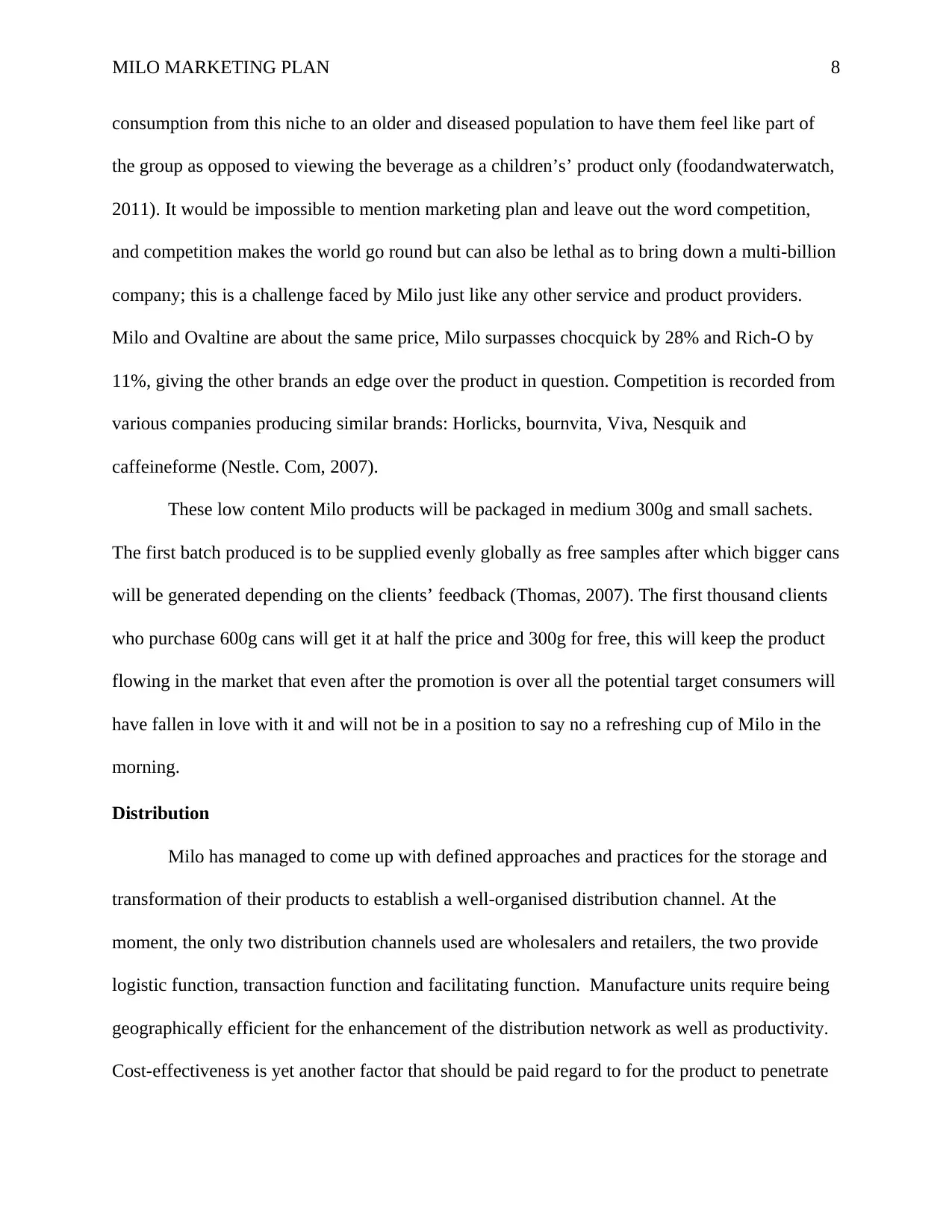
MILO MARKETING PLAN 8
consumption from this niche to an older and diseased population to have them feel like part of
the group as opposed to viewing the beverage as a children’s’ product only (foodandwaterwatch,
2011). It would be impossible to mention marketing plan and leave out the word competition,
and competition makes the world go round but can also be lethal as to bring down a multi-billion
company; this is a challenge faced by Milo just like any other service and product providers.
Milo and Ovaltine are about the same price, Milo surpasses chocquick by 28% and Rich-O by
11%, giving the other brands an edge over the product in question. Competition is recorded from
various companies producing similar brands: Horlicks, bournvita, Viva, Nesquik and
caffeineforme (Nestle. Com, 2007).
These low content Milo products will be packaged in medium 300g and small sachets.
The first batch produced is to be supplied evenly globally as free samples after which bigger cans
will be generated depending on the clients’ feedback (Thomas, 2007). The first thousand clients
who purchase 600g cans will get it at half the price and 300g for free, this will keep the product
flowing in the market that even after the promotion is over all the potential target consumers will
have fallen in love with it and will not be in a position to say no a refreshing cup of Milo in the
morning.
Distribution
Milo has managed to come up with defined approaches and practices for the storage and
transformation of their products to establish a well-organised distribution channel. At the
moment, the only two distribution channels used are wholesalers and retailers, the two provide
logistic function, transaction function and facilitating function. Manufacture units require being
geographically efficient for the enhancement of the distribution network as well as productivity.
Cost-effectiveness is yet another factor that should be paid regard to for the product to penetrate
consumption from this niche to an older and diseased population to have them feel like part of
the group as opposed to viewing the beverage as a children’s’ product only (foodandwaterwatch,
2011). It would be impossible to mention marketing plan and leave out the word competition,
and competition makes the world go round but can also be lethal as to bring down a multi-billion
company; this is a challenge faced by Milo just like any other service and product providers.
Milo and Ovaltine are about the same price, Milo surpasses chocquick by 28% and Rich-O by
11%, giving the other brands an edge over the product in question. Competition is recorded from
various companies producing similar brands: Horlicks, bournvita, Viva, Nesquik and
caffeineforme (Nestle. Com, 2007).
These low content Milo products will be packaged in medium 300g and small sachets.
The first batch produced is to be supplied evenly globally as free samples after which bigger cans
will be generated depending on the clients’ feedback (Thomas, 2007). The first thousand clients
who purchase 600g cans will get it at half the price and 300g for free, this will keep the product
flowing in the market that even after the promotion is over all the potential target consumers will
have fallen in love with it and will not be in a position to say no a refreshing cup of Milo in the
morning.
Distribution
Milo has managed to come up with defined approaches and practices for the storage and
transformation of their products to establish a well-organised distribution channel. At the
moment, the only two distribution channels used are wholesalers and retailers, the two provide
logistic function, transaction function and facilitating function. Manufacture units require being
geographically efficient for the enhancement of the distribution network as well as productivity.
Cost-effectiveness is yet another factor that should be paid regard to for the product to penetrate
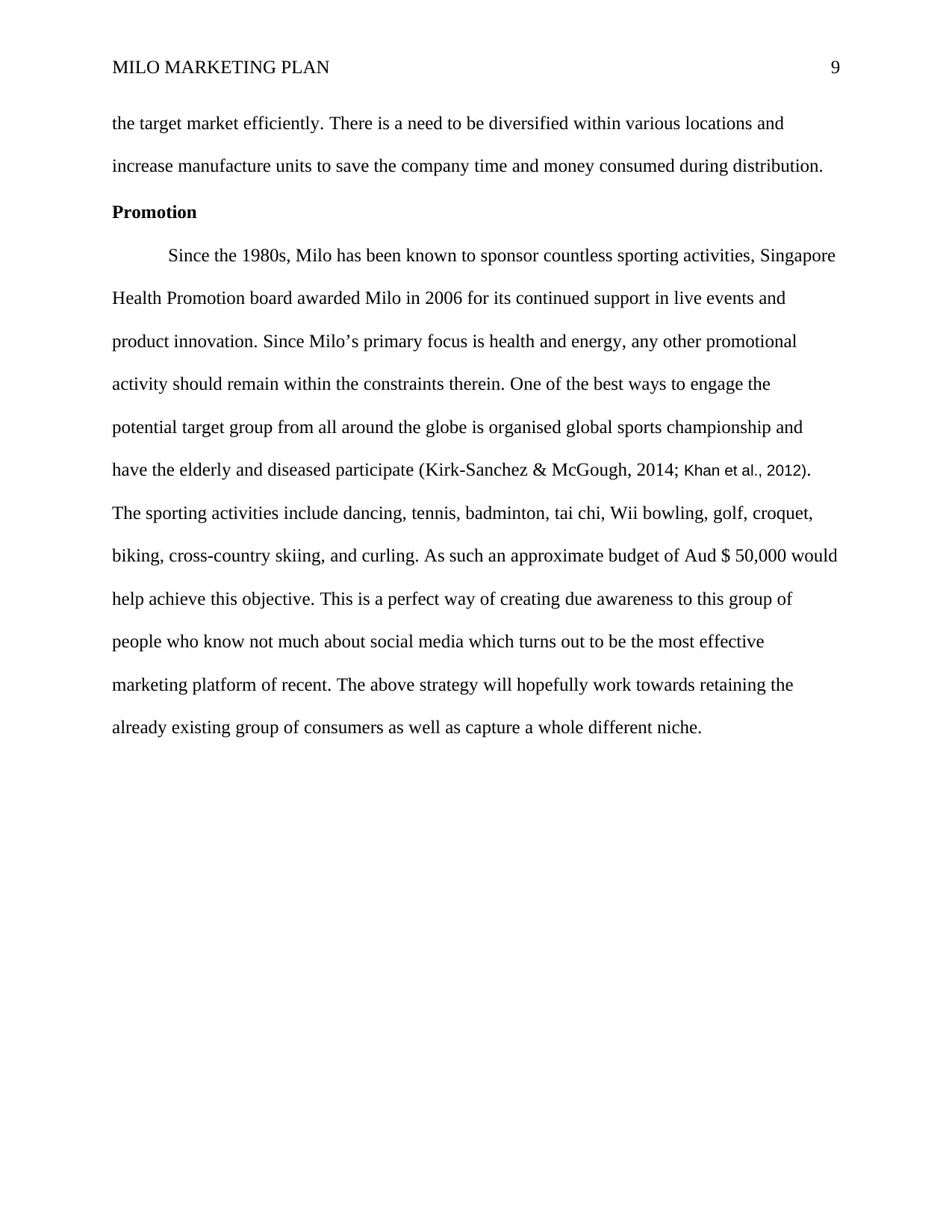
MILO MARKETING PLAN 9
the target market efficiently. There is a need to be diversified within various locations and
increase manufacture units to save the company time and money consumed during distribution.
Promotion
Since the 1980s, Milo has been known to sponsor countless sporting activities, Singapore
Health Promotion board awarded Milo in 2006 for its continued support in live events and
product innovation. Since Milo’s primary focus is health and energy, any other promotional
activity should remain within the constraints therein. One of the best ways to engage the
potential target group from all around the globe is organised global sports championship and
have the elderly and diseased participate (Kirk-Sanchez & McGough, 2014; Khan et al., 2012).
The sporting activities include dancing, tennis, badminton, tai chi, Wii bowling, golf, croquet,
biking, cross-country skiing, and curling. As such an approximate budget of Aud $ 50,000 would
help achieve this objective. This is a perfect way of creating due awareness to this group of
people who know not much about social media which turns out to be the most effective
marketing platform of recent. The above strategy will hopefully work towards retaining the
already existing group of consumers as well as capture a whole different niche.
the target market efficiently. There is a need to be diversified within various locations and
increase manufacture units to save the company time and money consumed during distribution.
Promotion
Since the 1980s, Milo has been known to sponsor countless sporting activities, Singapore
Health Promotion board awarded Milo in 2006 for its continued support in live events and
product innovation. Since Milo’s primary focus is health and energy, any other promotional
activity should remain within the constraints therein. One of the best ways to engage the
potential target group from all around the globe is organised global sports championship and
have the elderly and diseased participate (Kirk-Sanchez & McGough, 2014; Khan et al., 2012).
The sporting activities include dancing, tennis, badminton, tai chi, Wii bowling, golf, croquet,
biking, cross-country skiing, and curling. As such an approximate budget of Aud $ 50,000 would
help achieve this objective. This is a perfect way of creating due awareness to this group of
people who know not much about social media which turns out to be the most effective
marketing platform of recent. The above strategy will hopefully work towards retaining the
already existing group of consumers as well as capture a whole different niche.
⊘ This is a preview!⊘
Do you want full access?
Subscribe today to unlock all pages.

Trusted by 1+ million students worldwide
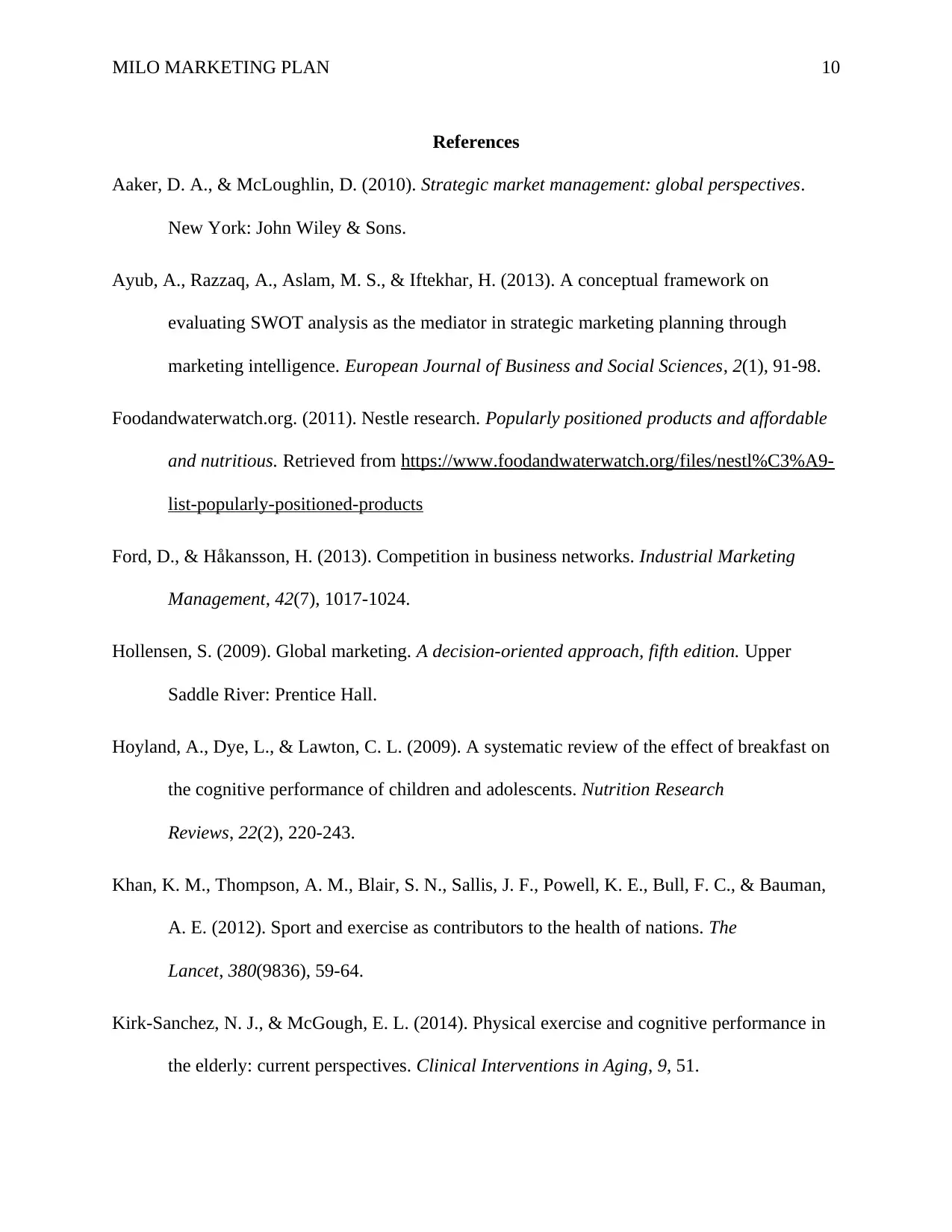
MILO MARKETING PLAN 10
References
Aaker, D. A., & McLoughlin, D. (2010). Strategic market management: global perspectives.
New York: John Wiley & Sons.
Ayub, A., Razzaq, A., Aslam, M. S., & Iftekhar, H. (2013). A conceptual framework on
evaluating SWOT analysis as the mediator in strategic marketing planning through
marketing intelligence. European Journal of Business and Social Sciences, 2(1), 91-98.
Foodandwaterwatch.org. (2011). Nestle research. Popularly positioned products and affordable
and nutritious. Retrieved from https://www.foodandwaterwatch.org/files/nestl%C3%A9-
list-popularly-positioned-products
Ford, D., & Håkansson, H. (2013). Competition in business networks. Industrial Marketing
Management, 42(7), 1017-1024.
Hollensen, S. (2009). Global marketing. A decision-oriented approach, fifth edition. Upper
Saddle River: Prentice Hall.
Hoyland, A., Dye, L., & Lawton, C. L. (2009). A systematic review of the effect of breakfast on
the cognitive performance of children and adolescents. Nutrition Research
Reviews, 22(2), 220-243.
Khan, K. M., Thompson, A. M., Blair, S. N., Sallis, J. F., Powell, K. E., Bull, F. C., & Bauman,
A. E. (2012). Sport and exercise as contributors to the health of nations. The
Lancet, 380(9836), 59-64.
Kirk-Sanchez, N. J., & McGough, E. L. (2014). Physical exercise and cognitive performance in
the elderly: current perspectives. Clinical Interventions in Aging, 9, 51.
References
Aaker, D. A., & McLoughlin, D. (2010). Strategic market management: global perspectives.
New York: John Wiley & Sons.
Ayub, A., Razzaq, A., Aslam, M. S., & Iftekhar, H. (2013). A conceptual framework on
evaluating SWOT analysis as the mediator in strategic marketing planning through
marketing intelligence. European Journal of Business and Social Sciences, 2(1), 91-98.
Foodandwaterwatch.org. (2011). Nestle research. Popularly positioned products and affordable
and nutritious. Retrieved from https://www.foodandwaterwatch.org/files/nestl%C3%A9-
list-popularly-positioned-products
Ford, D., & Håkansson, H. (2013). Competition in business networks. Industrial Marketing
Management, 42(7), 1017-1024.
Hollensen, S. (2009). Global marketing. A decision-oriented approach, fifth edition. Upper
Saddle River: Prentice Hall.
Hoyland, A., Dye, L., & Lawton, C. L. (2009). A systematic review of the effect of breakfast on
the cognitive performance of children and adolescents. Nutrition Research
Reviews, 22(2), 220-243.
Khan, K. M., Thompson, A. M., Blair, S. N., Sallis, J. F., Powell, K. E., Bull, F. C., & Bauman,
A. E. (2012). Sport and exercise as contributors to the health of nations. The
Lancet, 380(9836), 59-64.
Kirk-Sanchez, N. J., & McGough, E. L. (2014). Physical exercise and cognitive performance in
the elderly: current perspectives. Clinical Interventions in Aging, 9, 51.
Paraphrase This Document
Need a fresh take? Get an instant paraphrase of this document with our AI Paraphraser
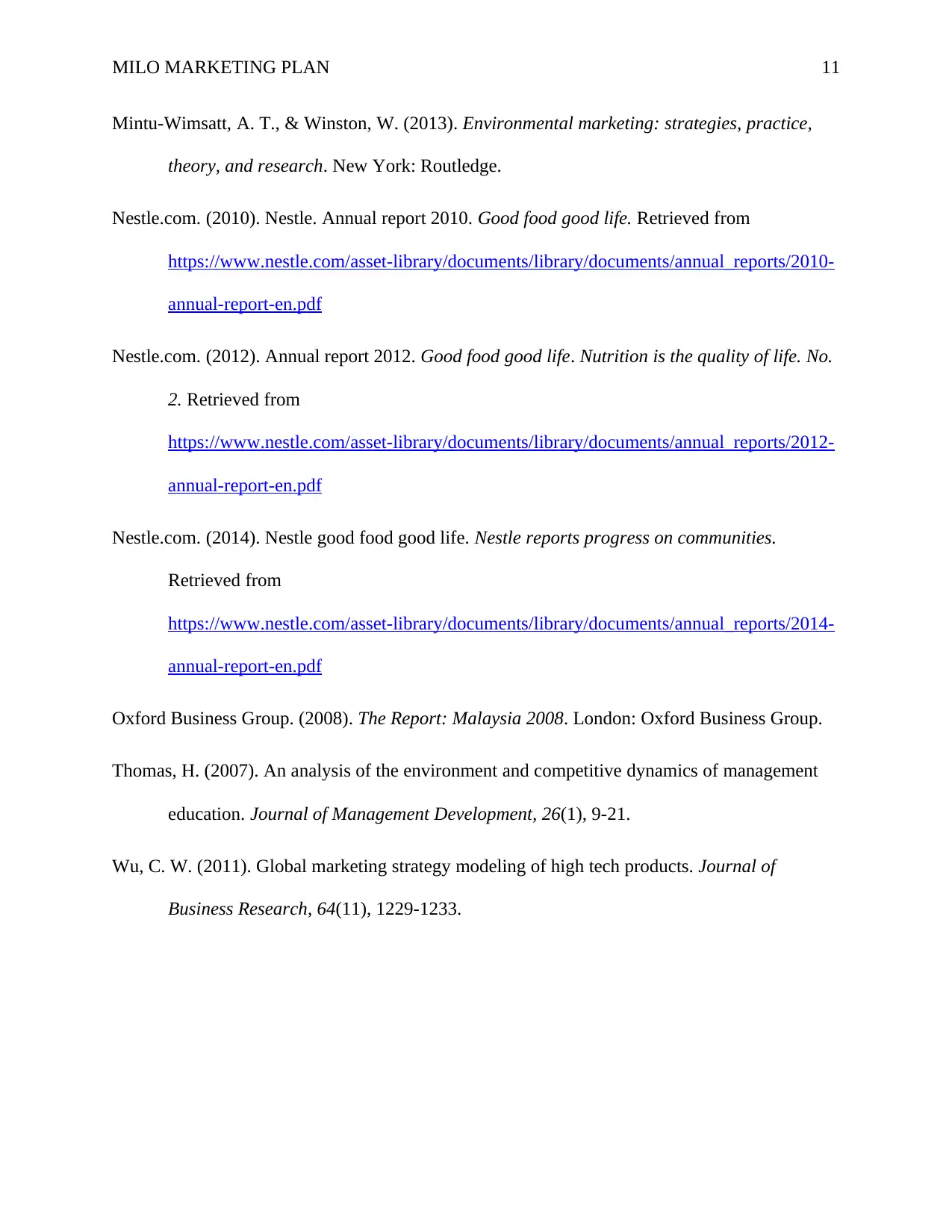
MILO MARKETING PLAN 11
Mintu-Wimsatt, A. T., & Winston, W. (2013). Environmental marketing: strategies, practice,
theory, and research. New York: Routledge.
Nestle.com. (2010). Nestle. Annual report 2010. Good food good life. Retrieved from
https://www.nestle.com/asset-library/documents/library/documents/annual_reports/2010-
annual-report-en.pdf
Nestle.com. (2012). Annual report 2012. Good food good life. Nutrition is the quality of life. No.
2. Retrieved from
https://www.nestle.com/asset-library/documents/library/documents/annual_reports/2012-
annual-report-en.pdf
Nestle.com. (2014). Nestle good food good life. Nestle reports progress on communities.
Retrieved from
https://www.nestle.com/asset-library/documents/library/documents/annual_reports/2014-
annual-report-en.pdf
Oxford Business Group. (2008). The Report: Malaysia 2008. London: Oxford Business Group.
Thomas, H. (2007). An analysis of the environment and competitive dynamics of management
education. Journal of Management Development, 26(1), 9-21.
Wu, C. W. (2011). Global marketing strategy modeling of high tech products. Journal of
Business Research, 64(11), 1229-1233.
Mintu-Wimsatt, A. T., & Winston, W. (2013). Environmental marketing: strategies, practice,
theory, and research. New York: Routledge.
Nestle.com. (2010). Nestle. Annual report 2010. Good food good life. Retrieved from
https://www.nestle.com/asset-library/documents/library/documents/annual_reports/2010-
annual-report-en.pdf
Nestle.com. (2012). Annual report 2012. Good food good life. Nutrition is the quality of life. No.
2. Retrieved from
https://www.nestle.com/asset-library/documents/library/documents/annual_reports/2012-
annual-report-en.pdf
Nestle.com. (2014). Nestle good food good life. Nestle reports progress on communities.
Retrieved from
https://www.nestle.com/asset-library/documents/library/documents/annual_reports/2014-
annual-report-en.pdf
Oxford Business Group. (2008). The Report: Malaysia 2008. London: Oxford Business Group.
Thomas, H. (2007). An analysis of the environment and competitive dynamics of management
education. Journal of Management Development, 26(1), 9-21.
Wu, C. W. (2011). Global marketing strategy modeling of high tech products. Journal of
Business Research, 64(11), 1229-1233.
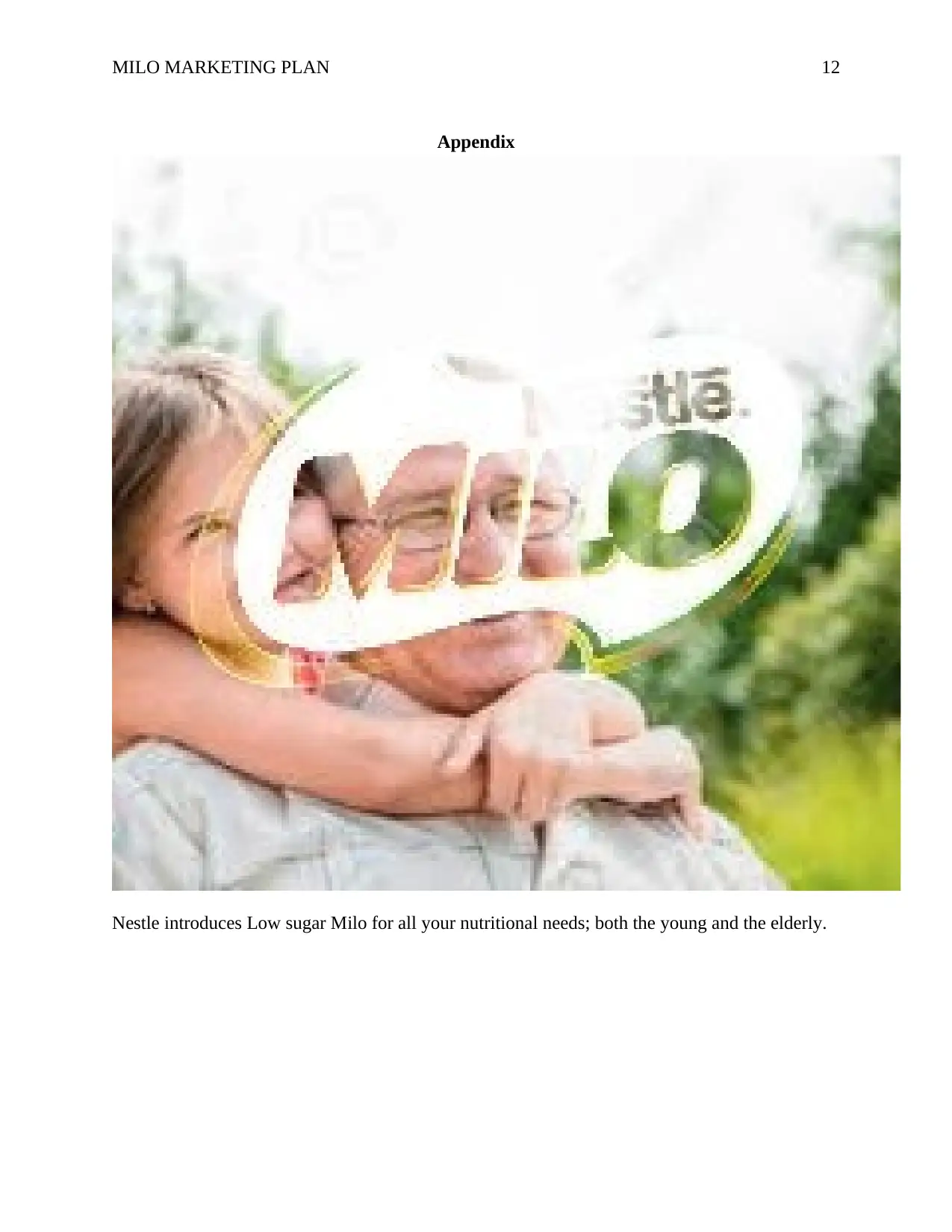
MILO MARKETING PLAN 12
Appendix
Nestle introduces Low sugar Milo for all your nutritional needs; both the young and the elderly.
Appendix
Nestle introduces Low sugar Milo for all your nutritional needs; both the young and the elderly.
⊘ This is a preview!⊘
Do you want full access?
Subscribe today to unlock all pages.

Trusted by 1+ million students worldwide
1 out of 12
Related Documents
Your All-in-One AI-Powered Toolkit for Academic Success.
+13062052269
info@desklib.com
Available 24*7 on WhatsApp / Email
![[object Object]](/_next/static/media/star-bottom.7253800d.svg)
Unlock your academic potential
Copyright © 2020–2025 A2Z Services. All Rights Reserved. Developed and managed by ZUCOL.





